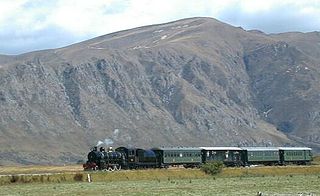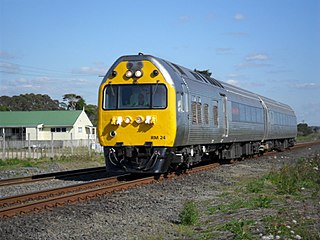Related Research Articles
Tranz Rail, formally Tranz Rail Holdings Limited, was the main rail operator in New Zealand from 1991 until it was purchased by Toll Holdings in 2003.

Rail transport in New Zealand is an integral part of New Zealand's transport network, with a nationwide network of 4,375.5 km (2,718.8 mi) of track linking most major cities in the North and South Islands, connected by inter-island rail and road ferries. Rail transport in New Zealand has a particular focus on bulk freight exports and imports, with 19 million net tonnes moved by rail annually, with 99.5% of New Zealand's exports and imports being transported through the country's seaports.

The Kingston Flyer is a vintage steam train in the South Island of New Zealand at the southern end of Lake Wakatipu. It used 14 kilometres of preserved track that once formed a part of the Kingston Branch. Originally, Kingston Flyer was a passenger express train between Kingston, Gore, Invercargill, and less frequently, Dunedin. It was operated by the New Zealand Railways (NZR) from the 1890s to 1957. In 1971, NZR revitalised the service as a tourist venture, later leasing the locomotives and rolling stock in 1982 to a private company. Since then, the Kingston Flyer has been through a number of owners, most recently being owned by the Kingston Flyer Ltd. A group of volunteers has restored the railway, rolling stock and locomotives to service. In July 2021 the Kingston Flyer received resource consent to operate, initially for tour groups.

The Dargaville Branch is a branch line railway that leaves the North Auckland Line not far south of Whangarei and runs westward to Dargaville. Construction of this relatively short line took approximately two decades, and when it was completed, it linked the now closed Donnellys Crossing Section with the national rail network. The branch has been closed to all traffic since 2014 and is currently used by a tourist railcart operation.
The Southerner was a passenger express train in New Zealand's South Island between Christchurch and Invercargill along the South Island Main Trunk, that ran from 1970 to 2002. It was one of the premier passenger trains in New Zealand and its existence made Invercargill the southernmost passenger station in the world.

The NZR RM class Edison battery-electric railcar was a railcar that ran in Canterbury, New Zealand for eight years. It was built for New Zealand Railways (NZR) as a prototype for battery-electric railcars. While the railcar, classified "RM 6", was considered the first successful railcar in New Zealand, it was later destroyed in a fire, and battery-electric traction for railcars was not developed further in New Zealand. Two other classes of battery-electric locomotives were introduced about the same time as RM 6, the E class of 1922 and the EB class of 1925.

Straits Air Freight Express (SAFE) was a cargo airline, established in 1950, named for its Cook Strait focus and connecting the North Island and South Islands of New Zealand's railway systems from the 1950s to the 1970s. The company was renamed Safe Air Limited in 1966 and diversified into aviation maintenance. In 1972 it was bought by the National Airways Corporation, which then merged with Air New Zealand. Safe Air continued to be operated as an independent entity by both owners. It ceased flying in 1990, but has continued to expand as a maintenance facility and now employs approximately 350 staff. In 2015 it was bought by the Australian arm of Airbus.

Interislander is a road and rail ferry service across New Zealand's Cook Strait, between Wellington in the North Island and Picton in the South Island. It is owned and operated by state-owned rail operator KiwiRail. Three roll-on roll-off (RORO) vessels operate the 50-nautical-mile route, taking about three hours to complete the crossing.
The New Zealand Railways Department, NZR or NZGR and often known as the "Railways", was a government department charged with owning and maintaining New Zealand's railway infrastructure and operating the railway system. The Department was created in 1880 and was corporatised on 1 April 1982 into the New Zealand Railways Corporation. Originally, railway construction and operation took place under the auspices of the former provincial governments and some private railways, before all of the provincial operations came under the central Public Works Department. The role of operating the rail network was subsequently separated from that of the network's construction. From 1895 to 1993 there was a responsible Minister, the Minister of Railways. He was often also the Minister of Public Works.
This is a list of jargon commonly used by railfans and railway employees in New Zealand.
The Bay Express was a passenger train between Wellington and Napier in New Zealand's North Island, operating from Monday, 11 December 1989 until Sunday, 7 October 2001. It was operated by New Zealand Railways Corporation's InterCity Rail division, later known as Tranz Scenic.

The Whitecliffs Branch was an 18.4 kilometres (11.4 mi) long branch line railway that formed part of New Zealand's national rail network in the Canterbury region of the South Island. It was more industrial than the many rural branches on the South Island's east coast whose traffic primarily derived from agriculture, and it operated from 1875 until 1962.

The RM class was the classification used by the New Zealand Railways Department (NZR) and its successors gave to most railcars and railbuses that have operated on New Zealand's national rail network. "RM" stands for Rail Motor which was the common name at the turn of the 20th century for what became known in New Zealand as railcars. As many types of railcars are operated, class names have been given to each railcar type to differentiate them from others.

The NZR RM class Sentinel-Cammell was a steam-powered railcar operated by the New Zealand Railways Department (NZR). It was the only one of its type to operate in New Zealand, and one of only two steam railcars trialled in the country; the other was the Clayton steam railcar.

New Zealand Railways Corporation (NZRC) is the state-owned enterprise that owns the land beneath KiwiRail's railway network on behalf of the Crown. The Corporation has existed under a number of guises since 1982, when the old New Zealand Railways Department was corporatised followed by deregulation of the land transport sector. In 1986, the Corporation became a State-owned enterprise, required to make a profit. Huge job losses and cutbacks ensued, and the rail network, rail operations and ferry service of the Corporation were transferred to New Zealand Rail Limited in 1990. The Corporation retained ownership of the land beneath the railway network, and charged a nominal rental to New Zealand Rail, which was privatised in 1993, and renamed Tranz Rail in 1995. In 2004, following a deal with Tranz Rail's new owners Toll NZ, the Corporation took over responsibility for maintaining and upgrading the rail network once more, trading under the name ONTRACK. Negotiations with Toll over track access charges concluded after four years with no agreement reached, so the government purchased the entire rail and ferry operations, naming the service KiwiRail. ONTRACK's railway infrastructure and employees were then transferred to KiwiRail in 2008, which itself was initially a subsidiary of the Corporation. On 31 December 2012, the Corporation once again became the landowner.

Western Hutt railway station, formerly Lower Hutt, is an intermediate station on the single-track Melling Line in Lower Hutt, New Zealand, It is served by Metlink electric multiple unit trains operated by Transdev Wellington under the Metlink brand.
The Nelson–Blenheim notional railway (1957–1979) was part of the political management of the backlash from the New Zealand Railways Department's closure of the isolated Nelson Section, which ended hopes for a southern connection of Nelson to the rest of the South Island railway network.
The Tāneatua Branch is a 25 kilometres (16 mi) long branch railway line in the Bay of Plenty, New Zealand, running from Hawkens Junction, west of Edgecumbe, to Tāneatua.

Great Journeys New Zealand is the tourism division of KiwiRail that operate its three Scenic train services. The new division was launched in May 2017 and replaced the former tourism brand KiwiRail Scenic Journeys. It has continuity with the earlier InterCity Rail (1987–1995) and Tranz Scenic (1995–2011).
References
- ↑ "National Library of New Zealand - Rails". National Library of New Zealand . Retrieved 24 October 2019.
- ↑ "A Note About Rails Magazine". Rails: 2. November 1974.
- ↑ "Light at the End of the Tunnel". Rails: 3. April 1975.
- ↑ "Rails catalogue entry - State Library of New South Wales". State Library of New South Wales . Retrieved 24 October 2019.
- ↑ "A message from the publishers of Rails". Rails. 33 (5): 105. December 2003.
- ↑ Comment by Robin Bromby, December 2019
- ↑ "Tranz Rail passenger trains coming to end of the line". New Zealand Herald. 11 October 2000. Retrieved 26 October 2019.
- ↑ "Steel backbone an economic lifeline". New Zealand Herald. 8 August 2008. Retrieved 26 October 2019.